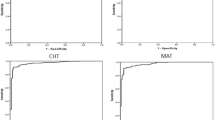Abstract
An enzyme-linked immunosorbent assay (ELISA) for the detection of IgG antibodies to Babesia microti antigen was developed. B. microti antigens were harvested from experimentally infected hamster blood and used as a coating antigen. The sensitivity and specificity of the IgG ELISA relative to immunofluorescent antibody assay (IFA) testing was 95.5% and 94.1%, respectively. According to the receiver operating characteristic curve analysis, the area under the curve was 0.987. No cross-reactivity of serum samples collected from patients infected with Toxoplasma gondii, Borrelia burgdorferi, Anaplasma phagocytophilum, Bartonella quintana, Dengue virus, or West Nile virus was detected. Cross-reactivity was observed with one of 35 sera from patients infected with Bartonella henselae. These results indicate that the established ELISA methods could be utilized as an accurate measure for the clinical diagnosis of human babesiosis.


Similar content being viewed by others
Literature Cited
V Babes (1888) ArticleTitleSur l’hemoglobinurie bacterienne boeuf C R Acad Sci 107 692–694
MR Boustani JA Gelfand (1996) ArticleTitleBabesiosis Clin Infect Dis 22 611–615 Occurrence Handle8729197
P Brasseur A Gorenflot (1996) ArticleTitleHuman babesial infections in Europe Rocz Akad Med Bialymst 41 117–122 Occurrence Handle8673796
ES Eskow PJ Krause A Spielman K Freeman J Aslanzadeh (1999) ArticleTitleSouthern extension of the range of human babe- siosis in the eastern United States J Clin Microbiol 37 2051– 2052 Occurrence Handle10325378
ME Gombert EJ Goldstein JL Benach MJ Tenenbaum E Grunwaldt MH Kaplan et al. (1982) ArticleTitleHuman babesiosis. Clinical and therapeutic considerations JAMA 248 3005–3007 Occurrence Handle10.1001/jama.248.22.3005 Occurrence Handle6890585
A Gorenflot K Moubri E Precigout B Carcy TP Schetters (1998) ArticleTitleHuman babesiosis Ann Trop Med Parasitol 92 489–501 Occurrence Handle10.1080/00034989859465 Occurrence Handle9683900
M Granstrom (1997) ArticleTitleTick-borne zoonoses in Europe Clin Microbiol Infect 3 156–169 Occurrence Handle11864099
GR Healy TK Ruebush Suffix2nd (1980) ArticleTitleMorphology of Babesia microti in human blood smears Am J Clin Pathol 73 107–109 Occurrence Handle7188717
B Herwaldt DH Persing EA Precigout WL Goff DA Mathiesen PW Taylor et al. (1996) ArticleTitleA fatal case of babesiosis in Missouri: identification of another piroplasm that infects humans Ann Intern Med 124 643–650 Occurrence Handle8607592
BL Herwaldt AM Kjemtrup PA Conrad RC Barnes M Wilson MG McCarthy et al. (1997) ArticleTitleTransfusion-transmitted babesiosis in Washington State: first reported case caused by a WA1-type parasite J Infect Dis 175 1259–1262 Occurrence Handle9129100
BL Herwaldt PC McGovern MP Gerwel RM Easton RR MacGregor (2003) ArticleTitleEndemic babesiosis in another eastern state: New Jersey Emerg Infect Dis 9 184–188 Occurrence Handle12603988
BL Herwaldt DF Neitzel JB Gorlin KA Jensen EH Perry WR Peglow et al. (2002) ArticleTitleTransmission of Babesia microti in Minnesota through four blood donations from the same donor over a 6-month period Transfusion 42 1154–1158 Occurrence Handle10.1046/j.1537-2995.2002.00189.x Occurrence Handle12430672
MJ Homer I Aguilar-Delfin SR Telford Suffix3rd PJ Krause DH Persing (2000) ArticleTitleBabesiosis Clin Microbiol Rev 13 451–469 Occurrence Handle10.1128/CMR.13.3.451-469.2000 Occurrence Handle10885987
RL Houghton MJ Homer LD Reynolds PR Sleath MJ Lodes V Berardi et al. (2002) ArticleTitleIdentification of Babesia microti- specific immunodominant epitopes and development of a peptide EIA for detection of antibodies in serum Transfusion 42 1488–1496 Occurrence Handle10.1046/j.1537-2995.2002.00215.x Occurrence Handle12421223
KP Hunfeld R Allwinn S Peters P Kraiczy V Brade (1998) ArticleTitleSerologic evidence for tick-borne pathogens other than Borrelia burgdorferi (TOBB) in Lyme borreliosis patients from midwestern Germany Wien Klin Wochenschr 110 901–908 Occurrence Handle10048174
KP Hunfeld A Lambert H Kampen S Albert C Epe V Brade et al. (2002) ArticleTitleSeroprevalence of Babesia infections in humans exposed to ticks in midwestern Germany J Clin Microbiol 40 2431–2436 Occurrence Handle10.1128/JCM.40.7.2431-2436.2002 Occurrence Handle12089258
AM Kjemtrup PA Conrad (2000) ArticleTitleHuman babesiosis: an emerging tick-borne disease Int J Parasitol 30 1323–1337 Occurrence Handle10.1016/S0020-7519(00)00137-5 Occurrence Handle11113258
PJ Krause SR Telford Suffix3rd RJ Pollack R Ryan P Brassard L Zemel et al. (1992) ArticleTitleBabesiosis: an underdiagnosed disease of children Pediatrics 89 1045–1048 Occurrence Handle1594345
PM Lantos PJ Krause (2002) ArticleTitleBabesiosis: similar to malaria but different Pediatr Ann 31 192–197 Occurrence Handle11905293
DA Leiby AP Chung RG Cable J Trouern-Trend J McCullough MJ Homer et al. (2002) ArticleTitleRelationship between tick bites and the seroprevalence of Babesia microti and Anaplasma phagocytophila (previously Ehrlichia sp.) in blood donors Transfusion 42 1585–1591 Occurrence Handle10.1046/j.1537-2995.2002.00251.x Occurrence Handle12473139
JH McQuiston JE Childs ME Chamberland E Tabor (2000) ArticleTitleTransmission of tick-borne agents of disease by blood transfusion: a review of known and potential risks in the United States Transfusion 40 274–284 Occurrence Handle10.1046/j.1537-2995.2000.40030274.x Occurrence Handle10738026
RK Pruthi WF Marshall JC Wiltsie DH Persing (1995) ArticleTitleHuman babesiosis Mayo Clin Proc 70 853–862 Occurrence Handle7643639
I Reiter G Weiland (1989) ArticleTitleRecently developed methods for the detection of babesial infections Trans R Soc Trop Med Hyg 83 IssueIDSuppl 21–23 Occurrence Handle10.1016/0035-9203(89)90598-1 Occurrence Handle2696156
R Ryan PJ Krause J Radoif K Freeman A Spielman R Lenz et al. (2001) ArticleTitleDiagnosis of babesiosis using an immunoblot serologic test Clin Diagn Lab Immunol 8 1177–1180 Occurrence Handle10.1128/CDLI.8.6.1177-1180.2001 Occurrence Handle11687460
RG Scholtens EH Braff GR Healey N Gleason (1968) ArticleTitleA case of babesiosis in man in the United States Am J Trop Med Hyg 17 810–813 Occurrence Handle4973053
MH Zweig G Campbell (1993) ArticleTitleReceiver-operating characteristic (ROC) plots: a fundamental evaluation tool in clinical medicine Clin Chem 39 561–577 Occurrence Handle8472349
Acknowledgments
The authors thank Dr. Maria E. Aguero-Rosenfeld for providing positive serum samples and Dr. Jason Trama for his critical review of this manuscript.
Author information
Authors and Affiliations
Corresponding author
Rights and permissions
About this article
Cite this article
Loa, C.C., Adelson, M.E., Mordechai, E. et al. Serological Diagnosis of Human Babesiosis by IgG Enzyme-Linked Immunosorbent Assay. Curr Microbiol 49, 385–389 (2004). https://doi.org/10.1007/s00284-004-4373-9
Received:
Accepted:
Published:
Issue Date:
DOI: https://doi.org/10.1007/s00284-004-4373-9




